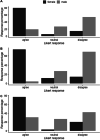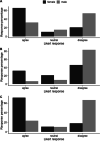Canadian women in otolaryngology: head and neck surgery part 2-challenges in family planning, fertility, and lactation
- PMID: 37221615
- PMCID: PMC10207624
- DOI: 10.1186/s40463-023-00630-z
Canadian women in otolaryngology: head and neck surgery part 2-challenges in family planning, fertility, and lactation
Abstract
Background: Previous literature demonstrates that female surgeons face difficulties in family planning, meeting breastfeeding goals, leadership and advancement opportunities. These issues have received limited attention in Canadian surgeons despite different maternity leave patterns compared to the general Canadian population. We sought to describe the experience of otolaryngologist-head and neck surgeons in family planning, fertility, and lactation and to identify the role of gender and career stage in these experiences.
Methods: A RedCAP® survey was disseminated to Canadian otolaryngology-head and neck surgeons and residents from March to May of 2021 through social media and the national listserv. This survey examined fertility, pregnancy losses, and infant feeding. Major independent variables include gender and career stage (faculty and resident). Dependent variables include respondent experiences with fertility, number of children, and length of parental leave. Responses were tabulated and presented descriptively to communicate the experience of Canadian otolaryngologists. Further, statistical comparisons such as chi-square and t-tests were employed to identify relationships between these variables. Thematic analysis was conducted for narrative comments.
Results: We received 183 completed surveys (22% response rate). 54% of females versus 13% of males agreed that career influenced their ability to have children (p = 0.002). 74% of female respondents without children have concerns about future fertility compared to 4% of men (p < 0.001). Furthermore, 80% of women versus 20% of men have concerns about future family planning (p < 0.001). The average maternity leave was 11.5 weeks for residents, and 22.2 weeks for staff. Additionally, significantly more women than men stated that maternity leave impacted advancement opportunities (32% vs. 7%) and salary/remuneration (71% vs. 24%) (p < 0.001). Over 60% of those choosing to pump breastmilk at work reported having inadequate time, space, and breastmilk storage. In total, 62% of breastfed infants were receiving breastmilk at 1 year.
Conclusion: Canadian female otolaryngologists-head and neck surgeons face challenges in family planning, ability to conceive, and breastfeeding. Focused effort is required to provide an inclusive environment that helps all otolaryngologists-head and neck surgeons achieve both their career and family goals, regardless of gender or career stage.
Keywords: Canadian otolaryngologists; Family planning; Fertility; Gender; Lactation.
© 2023. The Author(s).
Conflict of interest statement
There are no financial or non-financial competing interests to disclose.
Figures




Similar articles
-
The Intersection of Family Planning and Perception of Career Advancement in General Surgery.J Surg Res. 2024 Apr;296:481-488. doi: 10.1016/j.jss.2024.01.017. Epub 2024 Feb 6. J Surg Res. 2024. PMID: 38325010
-
Canadian Women in Otolaryngology-Head and Neck Surgery part 1: the relationship of gender identity to career trajectory and experiences of harassment.J Otolaryngol Head Neck Surg. 2023 Apr 24;52(1):31. doi: 10.1186/s40463-023-00629-6. J Otolaryngol Head Neck Surg. 2023. PMID: 37095567 Free PMC article.
-
Pregnancy and Fertility Trends Among Female Otolaryngologists.Otolaryngol Head Neck Surg. 2022 Oct;167(4):650-656. doi: 10.1177/01945998211064574. Epub 2021 Dec 14. Otolaryngol Head Neck Surg. 2022. PMID: 34905420
-
Breast-feeding and family planning: a review of the relationships between breast-feeding and family planning.Am J Clin Nutr. 1982 Jan;35(1):162-71. doi: 10.1093/ajcn/35.1.162. Am J Clin Nutr. 1982. PMID: 7039292 Review.
-
Canadian Contraception Consensus (Part 1 of 4).J Obstet Gynaecol Can. 2015 Oct;37(10):936-42. doi: 10.1016/s1701-2163(16)30033-0. J Obstet Gynaecol Can. 2015. PMID: 26606712 English, French.
Cited by
-
The timing of drain removal in parotidectomies: outcomes of removal at 4 h post-operatively and a Canadian survey of practice patterns.J Otolaryngol Head Neck Surg. 2023 Sep 13;52(1):60. doi: 10.1186/s40463-023-00665-2. J Otolaryngol Head Neck Surg. 2023. PMID: 37705038 Free PMC article.
-
Pregnancy challenges and outcomes among female physicians.Discoveries (Craiova). 2024 Sep 30;12(3):e192. doi: 10.15190/d.2024.11. eCollection 2024 Jul-Sep. Discoveries (Craiova). 2024. PMID: 39744502 Free PMC article. Review.
-
The double-edged scalpel: Experiences and perceptions of pregnancy and parenthood during Canadian surgical residency training.PLoS One. 2024 Mar 27;19(3):e0301190. doi: 10.1371/journal.pone.0301190. eCollection 2024. PLoS One. 2024. PMID: 38536844 Free PMC article.
-
Physician infertility: a structured literature review.J Assist Reprod Genet. 2024 Sep;41(9):2227-2235. doi: 10.1007/s10815-024-03216-4. Epub 2024 Aug 2. J Assist Reprod Genet. 2024. PMID: 39093321 Review.
References
-
- Findlay LC, Kohen DE. Leave practices of parents after the birth or adoption of young children. Stat Canada Cat. 2012;94:3–12.
-
- Family and Medical Leave Act. Disabil Compliance High Educ, 2020;26(3):16. Available from: https://www.dol.gov/agencies/whd/fmla
-
- Lawlor C, Kawai K, Tracy L, Sobin L, Kenna M. Women in otolaryngology: experiences of being female in the specialty. Laryngoscope. 2020;131:1–8. - PubMed
MeSH terms
LinkOut - more resources
Full Text Sources
Medical

